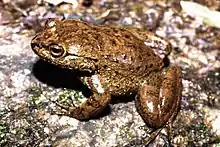| Phantasmarana boticariana | |
|---|---|
 | |
| Scientific classification | |
| Domain: | Eukaryota |
| Kingdom: | Animalia |
| Phylum: | Chordata |
| Class: | Amphibia |
| Order: | Anura |
| Family: | Hylodidae |
| Genus: | Phantasmarana |
| Species: | P. boticariana |
| Binomial name | |
| Phantasmarana boticariana (Giaretta and Aguiar, 1998)[2] | |
| Synonyms[3] | |
| |
Phantasmarana boticariana is a species of frog in the family Hylodidae. It is endemic to southeastern Brazil and only known from few specimens from its type locality, Parque Estadual do Itapetinga in Atibaia, São Paulo state.[1][4]
It was formerly placed in the genus Megaelosia, but was reclassified to Phantasmarana in 2021.[4][5]
Description
The type series consists of two females measuring 75 and 78 mm (3.0 and 3.1 in) and a juvenile measuring 47 mm (1.9 in) in snout–vent length, but the largest observed specimen was a female measuring 95 mm (3.7 in). The snout is rounded. The tympanum is small but distinct, despite being partly covered by the supratympanic fold. The finger and the toe tips are slightly enlarged. Toes hava basal webbing and extensive fringes. Skin is smooth but bne specimen has large, sparse warts on the dorsolateral parts of its body. The dorsum is yellowish-brown or green. There are many, small yellow blotches on the belly and the throat. The limbs are barred. The iris is copper with fine, black reticulation.[2]
The tadpoles are large, with a Gosner stage 25 specimen measuring 99 mm (3.9 in), of which the ovoid body makes 34%.[2]
Habitat and conservation
The type series was collected from a small, clean, cold montane rivulet in forest[1][2] at an elevation of 800 m (2,600 ft)[1] or 1,250 m (4,100 ft) above sea level.[2] Tadpoles were collected from deeper pools.[1][2]
This species is potentially threatened by habitat loss caused by fire and human settlement. The type locality is a protected area.[2]

References
- 1 2 3 4 5 Carlos Alberto Gonçalves da Cruz, Ana Maria Telles (2010). "Megaelosia boticariana". IUCN Red List of Threatened Species. 2010: e.T57181A11581559. doi:10.2305/IUCN.UK.2010-2.RLTS.T57181A11581559.en. Retrieved 14 November 2021.
- 1 2 3 4 5 6 7 Giaretta, Ariovaldo A. & Aguiar, Odair (1998). "A new species of Megaelosia from the Mantiqueira Range, southeastern Brazil". Journal of Herpetology. 32 (1): 80–83. doi:10.2307/1565483. JSTOR 1565483.
- ↑ Frost, Darrel R. (2018). "Megaelosia boticariana Giaretta and Aguiar, 1998". Amphibian Species of the World: an Online Reference. Version 6.0. American Museum of Natural History. Retrieved 25 September 2018.
- 1 2 "Phantasmarana boticariana (Giaretta and Aguiar, 1998)". Amphibian Species of the World. Retrieved 2022-09-11.
- ↑ Vittorazzi, S. E.; G. Augusto-Alves; D. Neves-da-Silva; A. M. P. T. de Carvalho-e-Silva; S. M. Recco-Pimentel; L. F. Toledo; L. B. Lourenço; D. P. Bruschi (2021). "Paraphyly in the giant torrent-frogs (Anura: Hylodidae: Megaelosia) and the description of a new genus". www.salamandra-journal.com. Retrieved 2022-09-11.
